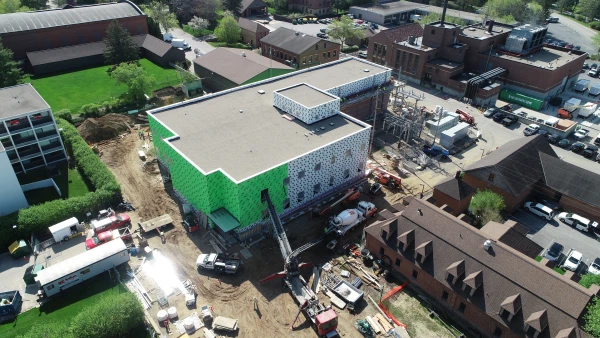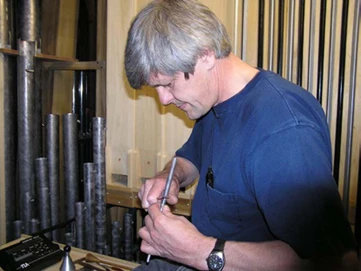Los Angeles, Calif., Jul 15, 2023 / 07:00 am
The Benedictines are returning to their ancient tradition of building church organs, according to Benedictine Father Lew Grobe, director of Saint John’s Abbey Woodworking and soon-to-launch Abbey Organ Builders in Collegeville, Minnesota.
Abbey Organ Builders will be officially dedicated on Oct. 17. Its inaugural commission is an organ for St. Michael the Archangel Parish in Leawood, Kansas. Not only will the shop build organs, but it will also serve as a school for artisans, passing the talent of organ-building on to future generations.

St. John’s Abbey was founded in 1856 to minister to German immigrants living in Minnesota. The community went on to found a university, prep school, liturgical press, manuscript library, and institute for ecumenical dialogue. Today, the community has 100 monks. The Benedictine motto is ora et labora (“work and prayer”); hence manual labor is an important component of the monks’ lives.
The community’s woodworking shop was established in the earliest days of the Collegeville community, harvesting lumber from the community’s 3,000 acres and using it to build furniture for the community’s extensive campus. A new larger woodshop, with space for organ-building facilities, is currently under construction. (Take a tour of the workshop under construction with Father Grove.)
Veteran craftsman Martin Pasi
Tacoma-based organ builder Martin Pasi of Pasi Organ Builders visited the abbey in 2019 to oversee the expansion of the Abbey church’s organ and came to admire the monks, their woodworking facility, and their abilities as artisans. It was his vision to integrate his 33-year-old company with the Abbey woodshop to create Abbey Organ Builders.
Pasi is from Austria and developed a love for the organ in his youth. He entered the organ-building industry, immigrated to the U.S., and worked at multiple firms before founding Pasi Organ Builders in 1990. His focus has been to create high-quality organs, with most used for worship. Additionally, unlike some firms that contract out parts of their work, all steps of building his organs occur under one roof.
Saint John’s Abbey Woodworking shop collaborated with Pasi in making the largest wooden bass pipes for the expansion of the Abbey’s organ, a project Pasi admits “I didn’t want to do at first.”
But when he and his staff arrived in Collegeville, “everything changed. The abbey is beautiful, the church is beautiful, and it has beautiful acoustics. I realized that there is something special going on there.”
As he was approaching an age when many retire, Pasi worried about the future of his business. He wants to continue making organs but has grown weary of the extensive administrative duties of the business. He had taught his daughter the organ-making trade, but she didn’t want to assume his leadership role. It was while in Collegeville that he came up with the idea of integrating his business with the abbey’s woodworking shop, with him relocating along with a few employees to continue building organs and to train a younger generation in the craft.
Pasi shared his vision with the monks, Grobe recalled, but the community was initially cool to the idea. “We thought it was a pipe dream,” Grobe joked.
However, Pasi said, it wasn’t long before “things began to develop.”

Benedictine history of organ-making
First, organ-making is part of the Benedictine tradition. Kevin Vogt, director of worship and sacred arts at St. Michael the Archangel Parish, Abbey Organ Builders’ first client, noted that the Benedictines have been world-renowned organ builders since the ninth century, with the organ used to enhance the liturgy, a key component of the evangelization of Europe.
(Story continues below)
Benedictine organ building began in England, he said, and then spread to the German-speaking regions around Lake Constance — Bavaria, Switzerland, and Austria — where Benedictine houses flourished for centuries.
The tradition reached its height in the 1700s with German masters Joseph Gabler, Karl Joseph Riepp, and Johann Nepomuk Holzhey, who all enjoyed associations with Benedictine monasteries. Riepp himself learned the art of organ building from Christoph Vogt, OSB, a priest of the Ottobeuren Abbey.
The most famous Benedictine organ builder was Dom Bédos de Celles (1709–1779), a monk of the Benedictine Congregation of Saint Maur whose 1766-78 treatise “The Art of the Organ-Builder” contains extensive details about 18th-century organ building and is still studied by modern organ makers.
The disruption and displacement of European monks during and after the French Revolution put an end to the Benedictines’ organ building until the present day, however, Vogt said.
In addition to organ-making being a part of Benedictine tradition, Pasi observed the skills of the Saint John’s Abbey monks and their lay helpers in the woodshop and saw that the organ is an important component of the monks’ daily prayer in the church five times daily.
The monks came to embrace the idea of producing organs under Pasi’s direction.
According to Vogt, Abbey Organ Builders will be a fully-functioning organ shop, “building organs from raw materials of wood and metal, using traditional methods employed in building the greatest historical organs and those of the finest contemporary organ builders.”
Pasi Organ Builders will complete its last organ, Opus 29, for a Catholic seminary in Cincinnati. Pasi will then move with two staff members — as well as all his tools he’s acquired for organ building over the past 33 years for his business — and take up residence near the abbey. “I am in awe to see the whole thing come together,” Pasi said.
The St. Michael's organ
The St. Michael’s organ will be the new shop’s Opus 1. Vogt opted to become Abbey Organ Builders’ first client because of his longtime relationship with Pasi, which began when Vogt was music director for St. Cecilia Cathedral in Omaha, Nebraska, and commissioned Pasi to build an organ for that church. They have collaborated on multiple projects since.
“We enjoyed a long, professional relationship and have spent 15 years designing this organ we’re planning for St. Michael’s,” Vogt said.
Opus 1 will have 45 stops, three manuals (keyboards,) a pedalboard (for the feet), and 3,216 pipes. Vogt anticipates it will be a world-class organ and become well known in his Archdiocese of Kansas City in Kansas.
The sound design of the organ will have its roots in the 17th- and 18th-century classical styles of Northern and Central Europe, Vogt said, with inspiration also from the great abbey organs in the region of the Hapsburg Empire.
“From these points of historical reference, Martin Pasi will craft a unique and completely new organ, thoroughly of its own time and place,” Vogt continued.
While the organ will rely on technology that was settled by 1750, it will also employ electricity for the operation of its stop action and the raising of the wind in its large bellows. The organ will be placed in a large gallery accommodating musicians serving at Mass but also serving as a dedicated liturgical space for the Liturgy of the Hours. The tonal specification of the organ has been designed to support this range of liturgical celebrations.
Work begins with the dedication in October, with an anticipated installation date midyear in 2025. Its cost will be between $1.5 million to $2 million.
Pasi hopes that Abbey Organ Builders will not only attract new business but also more artisans interested in learning how to build high-quality organs, as “there are not enough trained workers in my industry, and we want to change that.” He also hopes that the new shop will help spread a love for organ music and attract musicians interested in learning to play the instrument.
“Not long ago Abbey Organ Builders was only a dream,” Pasi said. “It is exciting to now see that dream come to fruition.”
Abbey Organ Builders can be reached through the wood shop’s website at www.sjawood.org.




